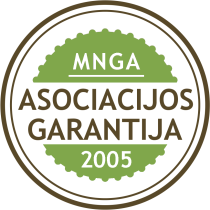Lithuanian wood houses industry
Like elsewhere in Europe, natural and eco-friendly wooden houses are raising merits in Lithuania, so the woodhouse industry is experiencing a stage of growth: new enterprises are established, business is expanded not only in the Lithuanian market but in foreign markets as well.
Manufacturers
According to the Association of Log Houses Producers (ALHP), today there are about 120 producers of log houses and about 100 producers of timber-framed houses in Lithuania. Most of them are small-sized enterprises without up to 50 employees, while the others can be attributed to the category of medium-sized and large enterprises.
Specialisation
About 50% of 120 producers of log houses manufacture machine-profiled log houses, 30% of them " handcrafted log houses and 20% - glued log houses.
About 80% of 100 producers of timber-framed houses make and construct panel or modular houses which components are prefabricated, and the rest of the companies build framework houses on construction sites.
Wood resources
Forests cover 33% of the territory in Lithuania. Therefore, the wood industry is by tradition one of the largest and strongest in Lithuania. Lithuanian producers of wooden houses consume approx. 300 thousand m³ of top-quality timber, mainly pine logs, per year. This accounts for roughly 8% of the total quantity of wood consumption in Lithuania per year. About 30% of wood is imported from Russia, the Ukraine and Belarus.
Technologies
Before 2004, most companies relied upon cheap labour force and little invested into production technologies. The situation fundamentally changed after Lithuania is accessing the EU followed by the rising cost of labour force. Industries turned to investing into new technologies, and this process is still continuing. They constantly look for new production methods, more advanced technologies and take efforts to assure production quality, as this is the only way for them to extend their markets.
Industry of component parts
Construction of wooden homes includes not only supplies of woodhouse structures, but also their component parts such as windows, doors, roofing structures and materials, furniture, etc. While specialising in the production and construction of wood homes, the producers are partnering with suppliers of individual house components. There is been a cluster formed in the woodhouse industries. The cluster companies share information and join their efforts to implement big complex projects.
Human resources
There are 2 universities in Lithuania training future scientists and highly skilled experts for wood industry. In addition, there is a quite well developed system for education and training of less skilled experts and workers. Not expensive and high-quality labour force is characteristic in Lithuania. Average wage here is one of the lowest in the European Union.
Foreign investments
Most log house producers are Lithuanian-capital companies; some of them are established and managed together with foreign partners. Yet, among producers of timber-framed houses there are quite many companies which are 100% foreign capital owned. In most cases foreign producers relocated production to Lithuania for lower production costs. The biggest foreign investors into the Lithuanian woodhouse industry are Norwegian, Danish, Finnish, Swedish and German companies.
Exports
Producers of wood houses export about 75% of their products to Scandinavian and Western European countries. The biggest export markets for wooden houses are Norway, Denmark, Sweden, Germany, France and the Netherlands. Some Lithuanian producers of wooden houses carry out their business in foreign countries only. According to the ALHP, about 1200 wooden houses were exported from Lithuania and built in foreign countries in 2007.
Trends
Lithuanian producers of wooden houses are successfully competing in foreign markets for several reasons. First of all, it's because of deep-rooted traditions of wood homes and strong wood industry in Lithuania. Quite cheap labour force and high qualifications are big competitive advantages on foreign markets. Labour costs account for a fairly big share in the structure of cost price of log houses. In addition, local resources of high-quality wood are also big. With a view to extending to foreign markets, producers of wooden houses implement advanced technologies and innovations, develop new products and improve corporate specialisation. This will serve as a basis for successful competing in global markets in future.





